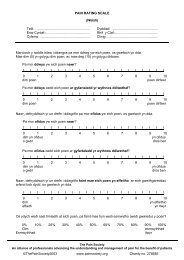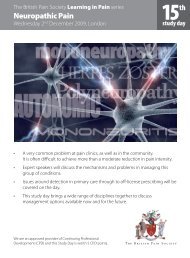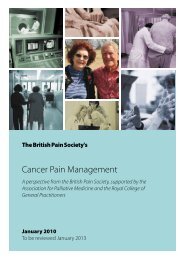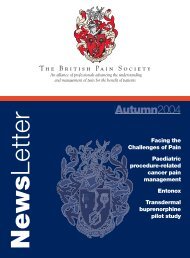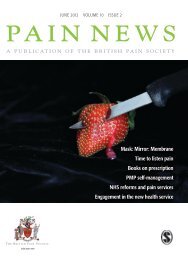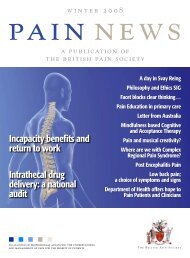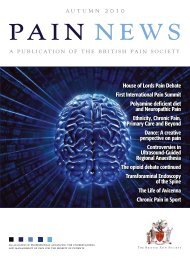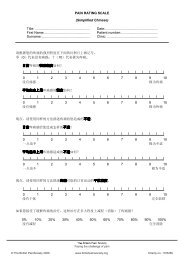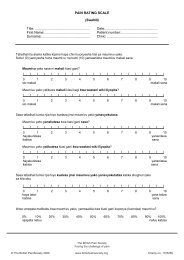Summer 2010 - The British Pain Society
Summer 2010 - The British Pain Society
Summer 2010 - The British Pain Society
Create successful ePaper yourself
Turn your PDF publications into a flip-book with our unique Google optimized e-Paper software.
CHANGING PRACTICE<br />
A Personal Reflection<br />
on the <strong>British</strong> <strong>Pain</strong><br />
Management Programme<br />
<strong>Society</strong> (SIG) Conference<br />
2009<br />
Dr Paul Wilkinson<br />
Consultant in <strong>Pain</strong> Management,<br />
Newcastle upon Tyne<br />
<strong>The</strong> <strong>Pain</strong> Management Programme<br />
held its 12th National SIG<br />
conference at Northumbria<br />
University in Newcastle upon Tyne.<br />
<strong>The</strong> title "Clearing the Fog on the<br />
Tyne” reflected not only the aims<br />
of the conference but also some<br />
nostalgia for the famous folk song<br />
from Lindisfarne, the band which,<br />
for many years, held Christmas<br />
concerts in Newcastle.<br />
As the Chair of the organising<br />
committee, I offer here a personal<br />
reflection of the conference.<br />
Although this meeting was many<br />
months ago the issues discussed<br />
continue to be both pertinent and<br />
topical. <strong>The</strong> aim is to provide a<br />
summary for the benefit of those<br />
who were unable to attend and<br />
serve as a reminder for some of<br />
those who did. Please note these<br />
are personal reflections and may<br />
reflect my own bias and memory!<br />
As well as focusing on core issues<br />
of pain management programmes,<br />
the conference attempted to<br />
consider issues allied to pain<br />
management programmes. In<br />
order to facilitate this, specialists in<br />
other fields were amongst those<br />
who were invited to help our<br />
understanding.<br />
Early Interventions in the<br />
Management for Chronic<br />
<strong>Pain</strong><br />
<strong>The</strong> conference began with<br />
Professor Chris Main of Keele<br />
University talking about designing<br />
and implementing early<br />
psychosocial interventions. What<br />
was made clear during his talk is<br />
that there is now a high level of<br />
consensus about those factors<br />
which predict chronicity. High<br />
risk groups such as depression,<br />
anxiety, high levels of early<br />
disability, catastrophisation,<br />
fear avoidance and other pain<br />
morbidity predicted prognosis<br />
and can be screened for early. It<br />
is clear that properly tailoring and<br />
targeting early interventions within<br />
clinical trials is not trivial, especially<br />
ensuring that interventions have<br />
appropriately been carried out.<br />
Despite these problems there<br />
is now clear evidence for the<br />
benefit of early psychosocial<br />
interventions. <strong>The</strong>re is a large,<br />
flourishing contemporary field of<br />
implementation science. This was<br />
probably news to many including<br />
myself.<br />
NICE Guidelines for Early<br />
Management of Persistent<br />
Low Back <strong>Pain</strong><br />
We asked Professor Martin<br />
Underwood, Professor for<br />
Research at Warwick University<br />
to help us understand better<br />
the procedural elements of<br />
undertaking NICE guidelines.<br />
He was Chair of guidance<br />
published in 2009. Clearly these<br />
guidelines have been highly<br />
controversial. <strong>The</strong> guidelines are<br />
very procedurally driven and<br />
have to rigorously adhere to<br />
these procedures. Those involved<br />
expose themselves to considerable<br />
media and professional interest.<br />
Professor Underwood defined<br />
the scope of the guidelines which<br />
had initially been between 6<br />
weeks to 6 months and not to 1<br />
year. He outlined that referring to<br />
spinal surgeons but not referral<br />
to pain clinics was considered as<br />
part of the scope. He discussed<br />
the procedures and how the<br />
workings of the reference group<br />
operated. In order to illustrate<br />
the link between the conclusions<br />
and the evidence, he focused<br />
on the most controversial areas<br />
namely acupuncture and injection<br />
of therapeutic substances into<br />
the back. As we now know these<br />
issues are still the subject of<br />
much controversy and discussion<br />
at both NICE and the BPS ( see<br />
the joint letter published by<br />
NICE and the BPS in this issue).<br />
For interventional procedures<br />
this had only led to one low<br />
powered admissible study and in<br />
contrast, according to Professor<br />
Underwood, there were several<br />
recognised controlled studies<br />
for acupuncture. Another area<br />
which is the subject of much<br />
debate. Further discussions were<br />
undertaken about the nature and<br />
the validity of all the evidence<br />
presented in the document.<br />
Complex arguments about the<br />
nature of any evidence will no<br />
doubt continue. All at the meeting<br />
(including many from the BPS)<br />
will be proactive in ensuring<br />
the best care for all patients. Dr.<br />
David Walsh, Associate Professor<br />
in Rheumatology at Nottingham<br />
and Chair of the SIG highlighted<br />
that the NICE guidelines had<br />
recognised the benefits of<br />
physical and psychological<br />
treatment in people who display<br />
high disability or significant<br />
psychological distress early. This<br />
was obviously of great interest to<br />
all PMP SIG members. <strong>The</strong> CPP<br />
programme (combined physical<br />
and psychological programme)<br />
is recommended before the<br />
pain becomes permanent and<br />
before all treatment options have<br />
been exhausted. Successful CPP<br />
programmes require specialist<br />
multi-disciplinary input helped<br />
by CBT within group settings.<br />
Healthcare providers have an<br />
obligation to put NICE guidelines<br />
into practice but there was anxiety<br />
as to whether money for these<br />
interventions would come from<br />
existing funding or otherwise.<br />
Update on catastrophisation<br />
Professor Michael O'Sullivan<br />
from McGill University in Canada<br />
updated us on catastrophisation.<br />
A tour de force again! One<br />
particularly interesting fact out of<br />
many is that catastrophisation can<br />
carry a considerable amount of<br />
the variance in treatment during<br />
a trial. It has been shown in some<br />
trials that if the castastrophisers<br />
are included in the trials then<br />
the treatment appears not to<br />
work but if they are taken out<br />
the treatment does! Treatment<br />
resistance of catastrophisers<br />
needs to be considered<br />
carefully in the planning of care<br />
and specific interventions to<br />
minimise the consequences of<br />
5 6<br />
PAI N N E W S S U M M E R <strong>2010</strong>




